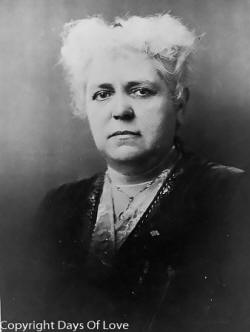

Partner Carrie Chapman Catt
Queer Places:
20 Ryder Rd, Briarcliff Manor, NY 10510, Stati Uniti
257 Central Park West, New York, NY 10024, Stati Uniti
Woodlawn Cemetery, E 233rd St & Webster Avenue, Bronx, NY 10470, Stati Uniti
 Mary
"Mollie" Garrett Hay (August 29, 1857- August 29, 1928)[1]
was an American suffragist, community organizer, and president of the Women's
City Club of New York, the Woman Suffrage Party and the New York Equal
Suffrage League. Hay was known for creating woman's suffrage groups across the
country. She was also close to the notable suffragist,
Carrie
Chapman Catt, with one contemporary, Rachel Foster Avery, stating that Hay
"really loves" Catt.[2]
Carrie Chapman Catt, co-founder in 1902 of the IWSA, had two husbands who
predeceased her, but at her request she was buried next to her friend Mary Garrett Hay.
Their grave in the Bronx, New York, bears the inscription, ‘Here lie
two, united in friendship for 38 years through constant service to a
great cause’.
Mary
"Mollie" Garrett Hay (August 29, 1857- August 29, 1928)[1]
was an American suffragist, community organizer, and president of the Women's
City Club of New York, the Woman Suffrage Party and the New York Equal
Suffrage League. Hay was known for creating woman's suffrage groups across the
country. She was also close to the notable suffragist,
Carrie
Chapman Catt, with one contemporary, Rachel Foster Avery, stating that Hay
"really loves" Catt.[2]
Carrie Chapman Catt, co-founder in 1902 of the IWSA, had two husbands who
predeceased her, but at her request she was buried next to her friend Mary Garrett Hay.
Their grave in the Bronx, New York, bears the inscription, ‘Here lie
two, united in friendship for 38 years through constant service to a
great cause’.
Hay was born in Charlestown, Indiana, in 1857.[3] Her mother died when she was young and she would travel with her father, who was an important Republican, when he visited patients or had political work.[4] She was a devout Presbyterian.[5] Hay attended the Western Female Seminary between 1873 and 1874,[5] where she studied to become a pharmacist and later worked for her father's pharmacy.[4] Hay became involved in the temperance movement and then later joined a suffrage group where she met Carrie Chapman Catt,[6] possibly at a National American Woman Suffrage Association (NAWSA) convention.[7] In the summer of 1895, Hay and Catt moved in together for a while.[7] When Catt's husband, George died in 1905, Hay moved in with Catt permanently.[8] Hay took over the household responsibilities.[2] In 1896, when California was creating its state constitution, Hay, along with women she organized, worked to have women's suffrage be included, though the referendum for women to vote was narrowly defeated.[4] Her work in California gave her valuable experience in organizing.[9] Hay later created suffrage groups across the country.[4] In 1899, she and Catt traveled through 20 different states, made numerous speeches and attended 15 conventions.[8] At conventions, like one in Topeka in 1918, Hay advocated creating citizenship and civics classes for women.[10] Hay served as the president of the New York Equal Suffrage League from 1910 to 1918.[11] In 1912, she was the president of the group, The Daughters of Indiana.[12] She served as president of the Woman Suffrage Party (WSP) in 1915.[13] During her time in WSP, she organized the enrollment of thousands of women to vote in the state of New York.[14] Hay In 1919, she was also the president of the Women's City Club of New York (WCC).[15] Hay was nominated to the WCC in order to bring a strong leadership role to the civic organization.[16] Hay was also the president of the New York City League of Women Voters between 1918 and 1923.[11]
20 Ryder Rd, Briarcliff Manor, NY 10510, Stati Uniti
Hay became one of the first women in the Eastern United States to join a political party when she became a Republican.[3] She served as chair of the Republican Women's National Executive Committee in 1919 and 1920.[11] Hay ensured that women's suffrage remained an important plank in the Republican Party of the time.[17] She encouraged other women to join the party.[18] In 1920, Hay and Catt cast ballots for the first time for president, together.[19]
Hay died in Pelham at home of a heart attack.[3] She was found by Catt inside of their home.[20] Catt created a monument to Hay where she was buried, Woodlawn Cemetery.[21] After Catt died in 1947, she was buried next to Hay.[2] Their headstone reads, "Here lie two, united in friendship for 38 years through constant service to a great cause."[22]
Winter Wheat, a new musical by Cathy Bush about the ratification of the 19th Amendment in Tennessee, premiered at the Barter Theatre in 2016. The original version of the play had a limited run at the Barter in 2014. Hay and Carrie Chapman Catt are characters in the play. The show also features anti-suffragist Josephine Anderson Pearson and Tennessee state representative Harry T. Burn, who cast the deciding vote for ratification in Tennessee.[23]
My published books: